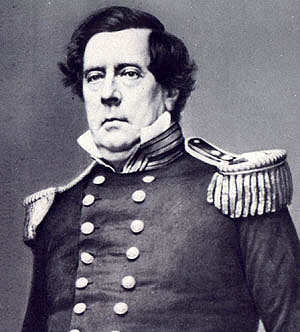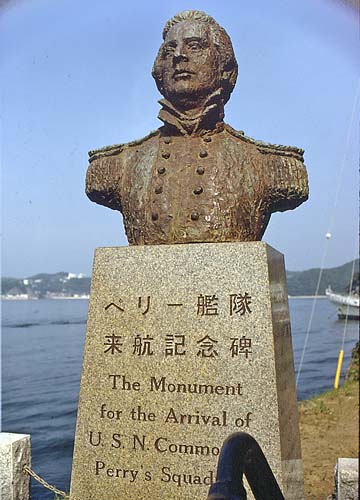<Back to Index>
- Physician Christian Friedrich Samuel Hahnemann, 1755
- Composer Eugen Francis Charles d'Albert, 1864
- U.S. Navy Commodore Matthew Calbraith Perry, 1794


Matthew Calbraith Perry (April 10, 1794 – March 4, 1858) was the Commodore of the U.S. Navy who compelled the opening of Japan to the West with the Convention of Kanagawa in 1854.
Matthew Perry was the son of Navy Captain Christopher R. Perry and the younger brother of Oliver Hazard Perry. Matthew Perry received a midshipman's commission in the Navy in 1809, and was initially assigned to the USS Revenge, under the command of his elder brother. Under his brother's command, Matthew was a combatant in The Battle of Lake Erie aboard the Flagship Lawrence and the replacement flagship, Niagara.
Commodore
Perry's early career saw him assigned to several ships, including the USS
President, which had been in a victorious engagement over a British vessel, HMS Little Belt,
shortly before the War
of
1812 was
officially declared. Aboard the USS President he served as aide to
Commodore John
Rodgers. He transferred to the USS United States,
and
saw little fighting in the war after that, since the ship was
trapped in port at New
London,
Connecticut. Following the signing of the Treaty
of
Ghent which
ended the conflict, he served on various vessels in the Mediterranean.
Perry
served
under Commodore William
Bainbridge during
the Second
Barbary
War. He then served in African waters aboard USS Cyane during its patrol off Liberia from 1819 - 1820. After
that cruise, Perry was sent to suppress piracy and the slave
trade in the West
Indies. Later during this period, while in port in Russia,
Perry
was offered a commission in the Imperial
Russian
Navy, which he declined. Perry
commanded the USS
Shark, a schooner with 12 guns, from
1821 - 1825. In 1763, when Britain possessed Florida, the Spanish
contended that the Florida
Keys were part of Cuba and North Havana. Certain
elements within the United States felt that Key West (which
was then named Cayo Hueso, meaning "Bone Key") could
potentially be the "Gibraltar of the West" because it guarded the
northern edge of the 90 mile (145 km) wide Straits
of
Florida -- the
deep water route between the Atlantic and the Gulf of
Mexico. In 1815
the Spanish governor in Havana deeded the island of Key
West to Juan
Pablo
Salas of Saint
Augustine. After Florida was transferred to the United States,
Salas sold Key West to U.S. businessman John W. Simonton for $2,000 in
1821. Simonton lobbied the U.S.
Government to
establish a naval base on Key West, both to take advantage of its
strategic location and to bring law and order to the area. On March
25, 1822, Perry sailed the Shark to Key West and planted the
U.S. flag, physically claiming the Keys as United States property.
Perry
renamed Cayo Hueso "Thompson's Island" for the Secretary of the Navy Smith
Thompson and the
harbor "Port Rodgers" for the president of the Board of Navy
Commissioners. Neither name stuck. From
1826 - 1827 Perry acted as fleet captain for Commodore Rodgers. Perry
returned to Charleston,
South
Carolina for
shore duty in 1828, and in 1830 took command of a sloop-of-war,
the USS Concord.
He spent the years 1833 - 1837 as second officer of the New York Navy
Yard (later the Brooklyn
Navy
Yard), gaining promotion to captain at the end of this tour. Perry
had
a
considerable interest in naval education, supporting an apprentice system to train new seamen,
and helped establish the curriculum for the United
States
Naval Academy. He was a vocal proponent of modernizing the
Navy. Once promoted to captain, he oversaw construction of the Navy's
second steam frigate the USS Fulton, which
he
commanded after its completion. He was called "The Father of the Steam
Navy", and he organized America's
first corps of naval engineers, and conducted the first U.S. naval
gunnery school while commanding Fulton in 1839 - 1841 off Sandy
Hook on the
coast of New
Jersey. Perry
received the title of Commodore in June 1840, when the Secretary
of
the Navy appointed
him
commandant of New York Navy Yard. The
United States Navy did
not have ranks higher than captain until 1862, so the title of
commodore carried considerable importance. Officially, an officer
would revert to his permanent rank after the squadron command
assignment had ended, although in practice officers who received the
title of commodore retained the title for life, and Perry was no
exception. During
his tenure in Brooklyn, he lived in Quarters B at Admiral's
Row, a building which still stands today, but is threatened with
demolition by the Brooklyn Navy Yard
Development Corporation. In 1843, Perry took command of the African
Squadron, whose duty was to interdict the slave
trade under the Webster-Ashburton
Treaty, and continued in this endeavor through 1844. In
1845,
Commodore David
Connor's length of service in command of the Home
Squadron had
come
to an end. However, the coming of the Mexican-American
War persuaded
the
authorities not to change commanders in the face of the war. Perry, who
would eventually succeed Connor, was made second in command and
captained the USS Mississippi.
Perry captured the Mexican city of Frontera,
demonstrated
against Tabasco and took part in the Tampico
Expedition. He had to return to Norfolk,
Virginia to make
repairs and was still there when the amphibious landings at Veracruz took place. His return to
the U.S. gave his superiors the chance to finally give him orders to
succeed Commodore Connor in command of the Home Squadron. Perry
returned to the fleet during the siege
of
Veracruz and his
ship supported the siege from the sea. After the fall of Veracruz Winfield
Scott moved inland
and Perry moved against the remaining Mexican port cities. Perry
assembled the Mosquito
Fleet and captured Tuxpan in April,
1847. In July 1847 he attacked
Tabasco personally,
leading
a 1,173-man landing force ashore and attacking the city from
land.
In
advance
of
his voyage to the Far East, Commodore Perry read widely
amongst available books about Tokugawa Japan. His research even
included consultation with the increasingly well-known Japanologist Philipp
Franz
von Siebold, who had lived on the Dutch island of Dejima for eight years before
retiring to Leiden in the Netherlands. Perry's
expedition to Japan was preceded by several naval expeditions by
American ships:
Perry
returned in February 1854 with twice as many ships, finding that the
delegates had prepared a treaty embodying virtually all the demands in
Fillmore's letter. Perry signed the Convention
of
Kanagawa on
March 31, 1854 and departed, mistakenly believing the agreement had
been made with imperial representatives. The agreement was made with
the Shogun, the de facto ruler of Japan. On his
way to Japan, Perry anchored off Keelung in Formosa (modern day Taiwan),
for
ten days. Perry and crew members landed on Formosa and investigated
the potential of mining the coal deposits in that area. He
emphasized in his reports that Formosa provided a convenient mid-way
trade location. Formosa was also very defensible. It could serve as a
base for exploration as Cuba had done for the Spanish in
the Americas. Occupying Formosa could help the US to counter European monopolization of the major trade routes. President
Pierce declined
the
suggestion, remarking such a remote possession would be an unnecessary
drain of resources and that he would be unlikely to receive the consent
of Congress. When
Perry
returned
to the United States in 1855, Congress voted to grant him a reward
of $20,000 in appreciation of his work in Japan. Perry used part of
this money to prepare and publish a report on the expedition in three
volumes, titled Narrative
of
the
Expedition of an American Squadron to the China
Seas and Japan.
He
was also advanced to the grade of rear-admiral on the retired list (when
his health began to fail) as a reward for his services in the Far East. Perry was known to have
suffered severe arthritis that left him in frequent pain, that on
occasion precluded him from his duties.
Perry
died
on
March 4, 1858 in New
York
City, of liver cirrhosis due to alcoholism.
His
remains
were moved to the Island
Cemetery in Newport,
Rhode
Island, on
March 21, 1866, along with those of his daughter, Anna, who died in
1839.
In
1852,
Perry
embarked from Norfolk,
Virginia for Japan,
in
command of a squadron in search of a Japanese trade treaty. Aboard a
black-hulled steam frigate, he ported Mississippi, Plymouth, Saratoga,
and Susquehanna at Uraga
Harbor near Edo (modern Tokyo)
on
July 8, 1853. His actions at this crucial juncture were informed by
a careful study of Japan's previous contacts with Western ships and
what could be known about the Japanese hierarchical culture. He was met
by representatives of the Tokugawa
Shogunate who told him to proceed to Nagasaki,
where
there
was limited trade with the Netherlands and
which
was
the only Japanese port open to foreigners at that time (see Sakoku).
Perry
refused to leave and demanded permission to present a letter from
President Millard
Fillmore, threatening force if he was denied. Perry ordered his
ships to attack several buildings around the harbor to demonstrate US
naval power. The Commodore was fully prepared for more hostilities if
his negotiations with the Japanese failed, and threatened to use
unrestrained fire if the Japanese refused to negotiate. He sent two
white flags to them, telling them to hoist the flags when they wished a
bombardment from his fleet to cease and to surrender. Perry's ships were equipped
with new Paixhans
shell
guns, capable of wreaking great destruction with every shell. The Japanese military
forces could not resist Perry's modern weaponry; the term "Black
Ships", in Japan, would later come to symbolise a threat imposed
by
Western technology.
The
Japanese government was forced to let Perry come ashore to avoid
further naval bombardment. Perry landed at Kurihama (in modern-day Yokosuka)
on
July
14, 1853 presented the letter to
delegates present, and left for the Chinese coast, promising to return
for a reply.
Fortifications
were
built in Tokyo
Bay at Odaiba in order to protect Edo
from a possible American naval incursion.